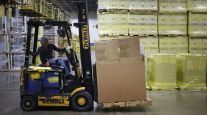Trailer Orders Jump in June But Lag Last Year by 7.1%
This story appears in the July 29 print edition of Transport Topics.
Fleets ordered 15,386 new trailers in June from U.S. manufacturers, an 8.6% increase from a year ago and the second monthly gain in the past three, ACT Research reported.
Last month’s order intake was 6.6% higher than May’s total of 14,428. However, through the first half of the year, net orders have totaled 106,126, down 7.1% from the 114,256 ordered during the first six months of 2012.
ACT analyst Frank Maly said June order activity was “a little light,” but not unusual.
“We’re at the point where a lot of people have made their decisions for this year,” he said. “They’re starting to look at what they’re going to do for next year, and those commitments really start to flow into the system in the October, November timeframe.”
Chris Hammond, vice president of marketing at Great Dane Trailers, said order intake has been “fairly consistent.”
“We haven’t seen too many big spikes up or down,” he said.
June order bookings at Utility Trailer Manufacturing Co. were up 13% from May, said Craig Bennett, senior vice president of sales and marketing. Even so, he said the company’s order backlog is declining because of higher production rates, and the company is on track to build a record number of trailers this year.
Although summer orders have been “OK so far,” fleets may go through a “digestion period” in the months ahead as they ascertain the cost of compliance with the federal hours-of-service changes that went into effect July 1, Bennett said.
At the same time, the overall economy “appears to be inching forward slowly,” he said.
Bennett said the customers who are buying new trailers are doing so in part to replace their existing equipment with lighter, more efficient models.
“The products are better, they’re lasting longer and they’re more productive, so they make more money with them,” he said.
Glenn Harney, chief sales officer for Hyundai Translead, said order activity is consistent with historic seasonal trends.
“We can best describe the markets today as steady at a comfortable level of production,” he said. “Replacement is all we are seeing and all we are likely to see until there is a measurable uptick in freight to be hauled.”
Harney said there are still no clear indicators that replacement trailers will be joined by growth in the near term.
“Rather than increased confidence I think we are seeing disciplined patience from the fleets,” he said. “We expect 2013 to continue pretty much as it has been so far this year, with order activity picking up in the fourth quarter for 2014 production. We remain hopeful that 2014 trailer orders will show some growth.”
David Giesen, vice president of sales and marketing at Stoughton Trailers, said the June orders total “falls within the industry’s seasonal norm for this period,” given that the summer months are typically the slowest of the year.
He said last month’s upturn reflects a “lag,” following lower-than-expected activity earlier in the year.
“There’s still some uncertainty on the economy and how that impacts trucking,” Giesen said. “People are moving ahead cautiously.”
Giesen said he expects orders to pick up late in the third quarter and into fourth quarter, which is “pretty typical of our past few years.”
“My belief is that we’re going to have a year very similar to last year in total volume,” he said.
Wabash National Corp. declined to comment due to the proximity of its quarterly earnings call.
ACT’s Maly said companies don’t see much need to grow their fleets right now, but added that the research firm is starting to hear some fleets say expansion may be necessary later this year, depending on the effects of the HOS changes.
Order cancellations returned to low levels in June after an upturn in the previous month, he said. As a percentage of incoming orders, cancellations dropped to 3.6%, from 7.9% in May.
“It’s an indication that people who have made their commitments are pretty solid on them,” said Maly, who said the change was driven by a decline in dry van cancellations.
Industry order backlogs are down about 6% to 7% from May — and about 11% lower than a year ago — but the orders currently on the books still represent about 3.6 months of production at current building rates, Maly said.


